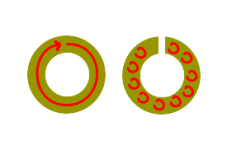Ed in KC
Forum Supporter
In a post yesterday, Carol used the expression “e-gads,” which is something I hadn’t heard for years, but it brought back memories of my mother, who used to use that term on occasion, usually an occasion brought on by me or my brother—she never cussed! Anyway, to make a long story short, I ended up getting into a box with various things that my mom left me, including some gold rings. One ring, a large 22k open wedding band that belonged to my paternal grandmother, when scanned over my SE coil, wouldn’t register at all, unless it was right by the coil. The same was true for a 10k open wedding band, but it wouldn’t register even if next to the coil, but when I scanned a closed 14k wedding band, it would register loud and clear. I changed coils, putting on my little X-5, thinking maybe it would pick the rings up, but I got the same results. Next I got my Bounty Hunter Land Star, exact same results with it; would neither of these detectors pick up a 22k or 10k ring—I was troubled, to say the least!
I turned the gain up to ten (it had been on 7), and now I was able to pick up the 22k ring at an inch-and-a-half, but that was it, and it was a faint, iffy signal at that. I looked over the 22k ring, wondering if it was counterfeit, then I got the idea to hold it closed together and pass it over the coil, and that made all the difference in the world; I could now pick it up at 7” over the X-5 coil with a loud, robust signal up to about 6”, and dying out ‘til 7”.
From now on, when I hunt tot lots, I’m turning the gain up to 10, and the sensitivity up as high as possible.
Second pic is of a diamond ring I found when I was a little kid: I found it lying in the street, and gave it to my mom. My parents took it to a jeweler, who said it was real, so then my mom gave it to her mom, because my grandmother had never had a diamond ring before, and it just happened to fit her. My mom got it back after my grandmother died, and then I got it back after my mother died.
HH'
Ed
I turned the gain up to ten (it had been on 7), and now I was able to pick up the 22k ring at an inch-and-a-half, but that was it, and it was a faint, iffy signal at that. I looked over the 22k ring, wondering if it was counterfeit, then I got the idea to hold it closed together and pass it over the coil, and that made all the difference in the world; I could now pick it up at 7” over the X-5 coil with a loud, robust signal up to about 6”, and dying out ‘til 7”.
From now on, when I hunt tot lots, I’m turning the gain up to 10, and the sensitivity up as high as possible.
Second pic is of a diamond ring I found when I was a little kid: I found it lying in the street, and gave it to my mom. My parents took it to a jeweler, who said it was real, so then my mom gave it to her mom, because my grandmother had never had a diamond ring before, and it just happened to fit her. My mom got it back after my grandmother died, and then I got it back after my mother died.
HH'
Ed







 the less that use a PI the better for me and my friends
the less that use a PI the better for me and my friends 

